When Reza Shah engaged in his Tehran coup in early 1921, there was no unitary Iranian army. Instead, there are a number of independent “official” forces composed of the following:
- The Persian Cossack brigade (7000 troops)
- The gendarmerie (12,000 troops)
- Former Qajar-era brigades in Tehran (1800 troops)
- Units beholden to the former (Qajar) ministry of war (2000 troops)
This left Iran with a minuscule force of 22,800 men. These were not a unitary force with the gendarmerie being the best trained and organized of all the above forces. The Qajar units (3800 troops in total) were wholly ineffective with the Persian Cossack brigade being first a Russian instrument and after the Bolshevik takeover, under the British influence. There were also the pro-British South Persia Rifles (S.P.R.) that had been formed during the First World War as noted again below.
In the first serious step towards restoring a unified army for Iran, Reza Shah ordered on December 6, 1921 for the Gendarmerie and the Persian Cossacks to be unified into a single military force. The South Persia Rifles (S.P.R.) created by the British during World War One had already been disbanded two months previous in October 1921. Numbers of the former S.P.R.’s Iranian officers and troops entered service into the new Iranian army. The formation of a single unified Iranian army beholden to the state (not foreign interests) had fulfilled one of the primary objectives of the early twentieth century Constitutionalist movement. Despite this achievement and others cited in this article, the new Iranian army had several challenges to face when the Anglo-Soviet invasion struck Iran on August 25, 1941. Organization of the Unitary Iranian Army As soon as he had seized power, Reza Shah proceeded to modernize and expand Iran’s newly formed unitary forces, known at this time as the Imperial Iranian Armed Services (IIAS). Reza Shah ordered the formation of five Lashgars on January 5, 1922, each to be composed of 10,000 men. These were as follows: This five-division system was then used organize the defense of the country into five military regions: By 1930 the Iranian government had allocated up to 50 percent of Iran’s GNP (gross national product) for the Iranian military for the following tasks: Below is a comparison of the numbers of rifles, machine guns and artillery in 1922 and 1941: In less than two decades Iran’s inventory of rifles and cannon had increased ten-fold with its machine gun stocks having expanded 120-fold. During that period Iran had ordered approximately 300,000 rifles, 350 cannon (mainly light and medium calibers – some of these motorized) along with 6000 heavy and light machine guns. This meant that by the Second World War most units of the Iranian army were equipped with modern rifles and machine guns. It is notable that while Iran did order much of its equipment from abroad, the military sector’s buildup of rifles, machine guns and artillery had been significantly assisted by the newly established Iranian armaments industries during 1922-1941. All of this was a remarkable achievement for a country that had been on the brink of chaos in the early 20th century. Under the Qajar administration, Iran had lacked a true national army capable of defending its borders against invasions and political interference. Despite their achievements, the Iranian army was beset with one big liability: the artillery corps still deployed obsolete equipment such as the 75mm Bofors mountain guns and the Shneider-Cruezot 75-mm cannon. These types of equipment had been in use during the Constitutional revolution in the early 20th century. This was a serious liability, a fact demonstrated when the Anglo-Soviet invasion struck Iran in August 1941. Iran in the 1922-1941 period succeeded in building up armored forces composed of tanks and combat vehicles. The first tanks to arrive into Iran were the French FT-17 light tanks in 1925. These were armed with the 7.92 mm machine gun. After the FT-17 light tanks came the US-made Marmon Herrington which was also armed with machine guns. Interestingly, the Marmon Herrington company was to also deliver numbers of trucks for the Iranian army prior to 1941. By the onset of the Anglo-Soviet invasion in August 25, 1941, Iran had a modest force of just 200 tanks. The most modern tanks in the Iranian inventory at the time were the Czech built AH–IV and TNH light tanks armed with the 37mm gun. The TNH rapidly gained popularity in Iran’s military and public circles. Iran had 300 more of these but none of these were to be delivered due to the Anglo-Soviet invasion in August 1941. By the onset of the Second World War Iran also fielded 102 non-tank armored vehicles, including the British Rolls Royce India (1921) Pattern armored cars armed with Vickers machine guns alongside more powerful vehicles such as the American made LaFrance TK-6 armored car which was armed with a 37cm main gun and two machine guns. Despite the creation of the armored corps, the Iranian army still relied upon its cavalry for rapid attack and maneuver. The primary reason for this was because the Iranian armored corps had yet to master such operations at the battlefield level. To implement an armored force capable of rapid and coordinated battle maneuvers, the Iranian army had to create and organize a professional officer cadre trained in the latest methods of European armored warfare. In practice, Iran did have numbers of highly trained officers schooled in the European tradition of armored warfare, but these often were barred from advancing to higher ranks due to endemic corruption within higher levels of command. A serious problem that had not been addressed was the Iranian army’s conscription system. Despite advancements in several areas, conscription continued to rely upon the antiquated Qajar-era Bunichah system. Put simply, in this system: The inefficient Bunichah system of recruitment helps explain why each of the army’s five divisions failed to reach its target strength of 10,000 men. Even by 1926, the army still had a small force of just 40,000 troops. Realizing the problem, the Iranian army implemented a more modern mass conscription system. This finally allowed the Iranian army to expand the size of its personnel. By 1930 the army had a complement of 85,000 men. These were supported by the newly established (or re-established) Gendarmerie service, known as the Amnieh: these stood at-12,000 men. By 1937 the army had expanded its forces to 105,000 troops by 1937. By the onset of World War Two, the Iranian army fielded a total of 16 divisions composed of 126,000 men.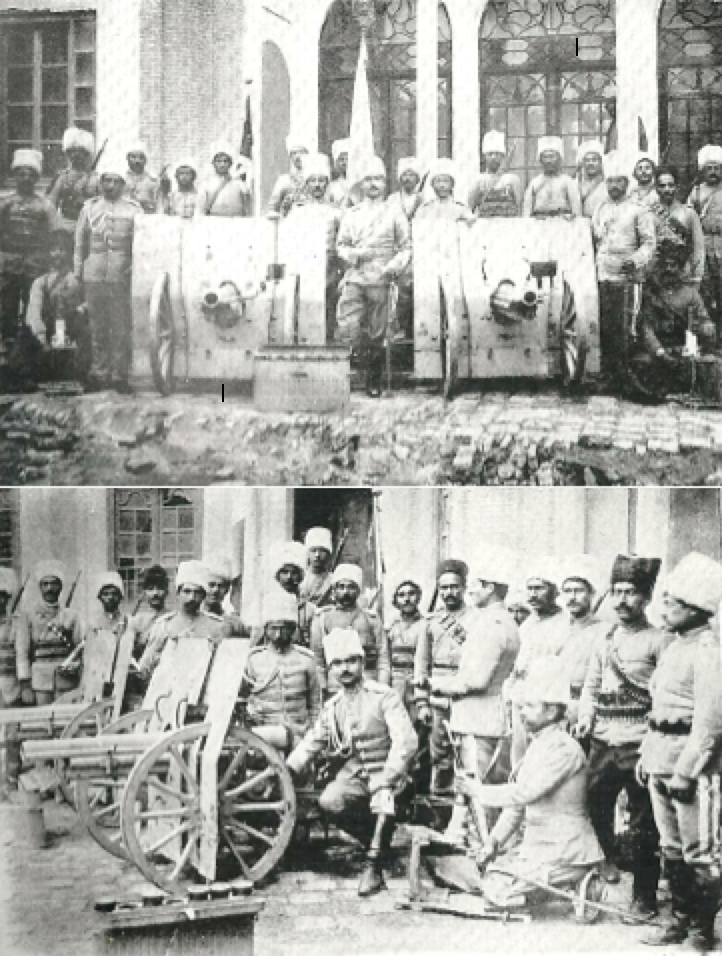
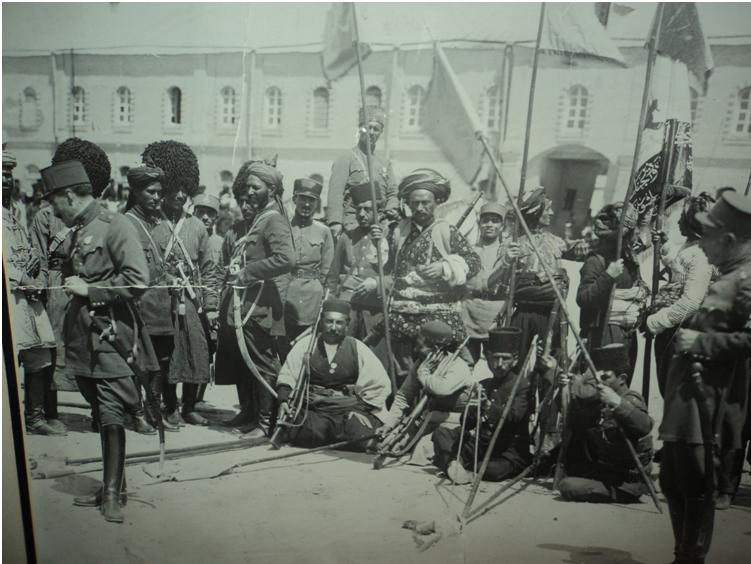 [CLICK TO ENLARGE] A photo taken in 1926 of a military assembly in Tehran (book cover for Iran at War: 1500-1988). This was the Iranian Army headquarters at the time and is today the Iranian University of the Arts (محوطه ساختمانی که قبلا ستاد ارتش بوده و الان دانشکده هنر است ). Note the diverse nature of the Iranian troops – reminiscent of the armies of Iran since antiquity: one can see Kurds, Azaris, Lurs, Baluchis, Qashqais, Persians, etc. partaking in the assembly. Note that Colonel Haji Khan (far left – hand on sword hilt) and the officer to the right are members of the Gendarmerie para-military forces. Haji Khan died just a year later when fighting as a colonel with the Iranian army against Bolshevik/Communist and Russian troops attempting to overrun northern Iran after World War One.
[CLICK TO ENLARGE] A photo taken in 1926 of a military assembly in Tehran (book cover for Iran at War: 1500-1988). This was the Iranian Army headquarters at the time and is today the Iranian University of the Arts (محوطه ساختمانی که قبلا ستاد ارتش بوده و الان دانشکده هنر است ). Note the diverse nature of the Iranian troops – reminiscent of the armies of Iran since antiquity: one can see Kurds, Azaris, Lurs, Baluchis, Qashqais, Persians, etc. partaking in the assembly. Note that Colonel Haji Khan (far left – hand on sword hilt) and the officer to the right are members of the Gendarmerie para-military forces. Haji Khan died just a year later when fighting as a colonel with the Iranian army against Bolshevik/Communist and Russian troops attempting to overrun northern Iran after World War One.
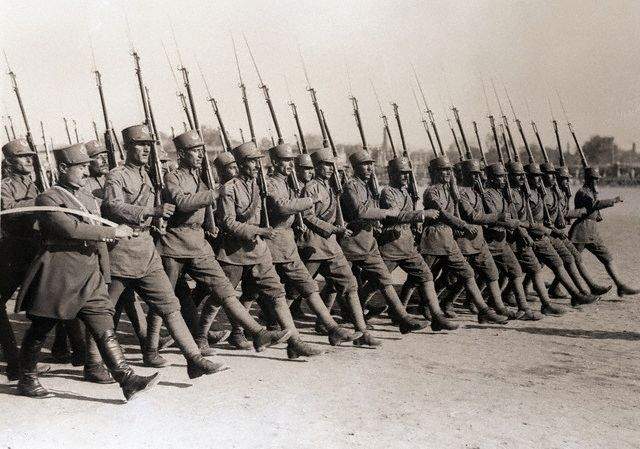 March-past of Iranian army troops in the 1930s or early 1940s (Source: lead-adventure.de).
March-past of Iranian army troops in the 1930s or early 1940s (Source: lead-adventure.de).  The Berno e Kootah (the short Berno) (Picture Source: Aliparsa.com). The required machinery and training for producing the Berno (Brno) rifles was provided by the Czech powerhouse firm, Škoda, which has had long-standing ties with the Iranian industrial sector. For more on the Berno (Brno) in Iranian army service see here…
The Berno e Kootah (the short Berno) (Picture Source: Aliparsa.com). The required machinery and training for producing the Berno (Brno) rifles was provided by the Czech powerhouse firm, Škoda, which has had long-standing ties with the Iranian industrial sector. For more on the Berno (Brno) in Iranian army service see here…
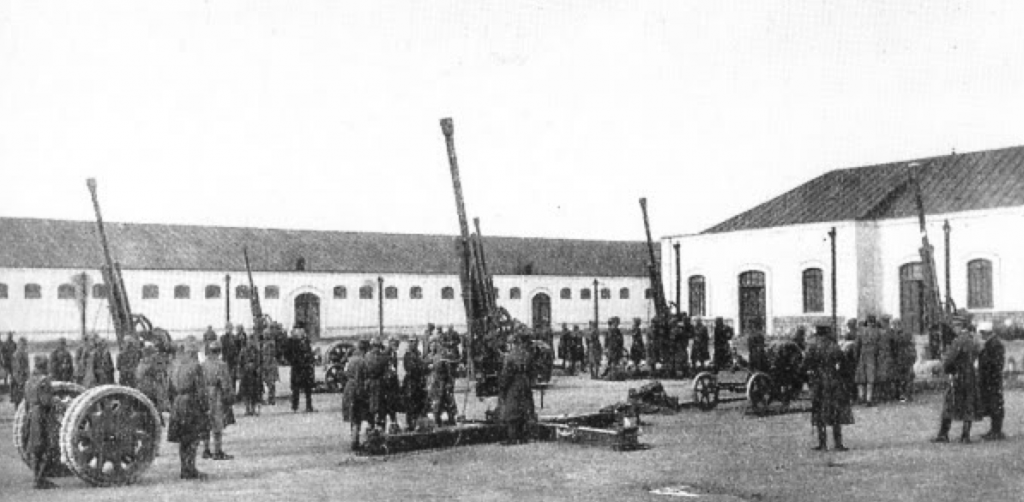 [Click to Enlarge] Iranian artillery unit of 75mm Bofors anti-aircraft artillery (Picture Source:Network54). At least another twenty of these which had been on order were never delivered to Iran.
[Click to Enlarge] Iranian artillery unit of 75mm Bofors anti-aircraft artillery (Picture Source:Network54). At least another twenty of these which had been on order were never delivered to Iran.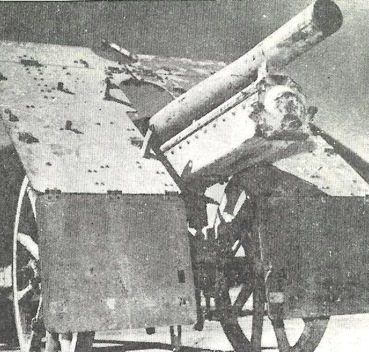 An old undated photo of an Iranian Swedish made Bofors 75mm mountain gun. These had seen service with the Iranian army since the early 20th century. Four of these have survived to this day, now on display at the gates of the Gilan barracks in northern Iran (Source: Matofi, A., 1999, Tarikh-e-Chahar Hezar Sal-e Artesh-e Iran: Az Tamadon-e Elam ta 1320 Khorsheedi, Jang-e- Iran va Araqh [The 4000 Year History of the Army of Iran: From the Elamite Civilization to 1941, the Iran-Iraq War]. Tehran:Entesharat-e Iman, p. 1043).
An old undated photo of an Iranian Swedish made Bofors 75mm mountain gun. These had seen service with the Iranian army since the early 20th century. Four of these have survived to this day, now on display at the gates of the Gilan barracks in northern Iran (Source: Matofi, A., 1999, Tarikh-e-Chahar Hezar Sal-e Artesh-e Iran: Az Tamadon-e Elam ta 1320 Khorsheedi, Jang-e- Iran va Araqh [The 4000 Year History of the Army of Iran: From the Elamite Civilization to 1941, the Iran-Iraq War]. Tehran:Entesharat-e Iman, p. 1043).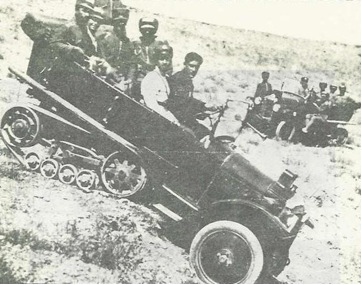 Iranian army personnel on maneuvers with what appear to be French made Citroen half-tracks. According to Matofi, these were the first half-tracks to enter service with the Iranian army in 1925 (Picture Source: Matofi, A., 1999, Tarikh-e-Chahar Hezar Sal-e Artesh-e Iran: Az Tamadon-e Elam ta 1320 Khorsheedi, Jang-e- Iran va Araqh [The 4000 Year History of the Army of Iran: From the Elamite Civilization to 1941, the Iran-Iraq War]. Tehran:Entesharat-e Iman, p.1045).
Iranian army personnel on maneuvers with what appear to be French made Citroen half-tracks. According to Matofi, these were the first half-tracks to enter service with the Iranian army in 1925 (Picture Source: Matofi, A., 1999, Tarikh-e-Chahar Hezar Sal-e Artesh-e Iran: Az Tamadon-e Elam ta 1320 Khorsheedi, Jang-e- Iran va Araqh [The 4000 Year History of the Army of Iran: From the Elamite Civilization to 1941, the Iran-Iraq War]. Tehran:Entesharat-e Iman, p.1045).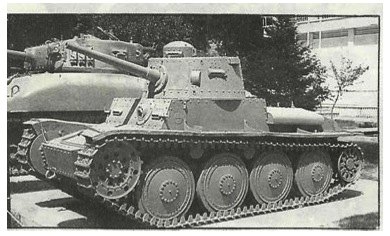 The TNH light tank of the Iranian army first delivered in 1937. Note the Sherman tank (delivered to Iran after World War Two) behind the TNH (Photo Source: (Picture Source: Matofi, A., 1999, Tarikh-e-Chahar Hezar Sal-e Artesh-e Iran: Az Tamadon-e Elam ta 1320 Khorsheedi, Jang-e- Iran va Araqh [The 4000 Year History of the Army of Iran: From the Elamite Civilization to 1941, the Iran-Iraq War]. Tehran:Entesharat-e Iman, p.1134).
The TNH light tank of the Iranian army first delivered in 1937. Note the Sherman tank (delivered to Iran after World War Two) behind the TNH (Photo Source: (Picture Source: Matofi, A., 1999, Tarikh-e-Chahar Hezar Sal-e Artesh-e Iran: Az Tamadon-e Elam ta 1320 Khorsheedi, Jang-e- Iran va Araqh [The 4000 Year History of the Army of Iran: From the Elamite Civilization to 1941, the Iran-Iraq War]. Tehran:Entesharat-e Iman, p.1134).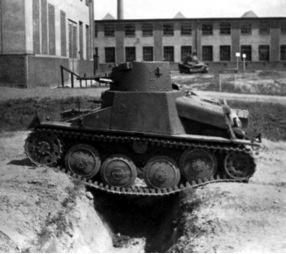 An AH-IV tankette engaged in practice drills in a Tehran barracks in the 1930s. Note the TNH light tank in the background (Photo Source: FSU.edu).
An AH-IV tankette engaged in practice drills in a Tehran barracks in the 1930s. Note the TNH light tank in the background (Photo Source: FSU.edu).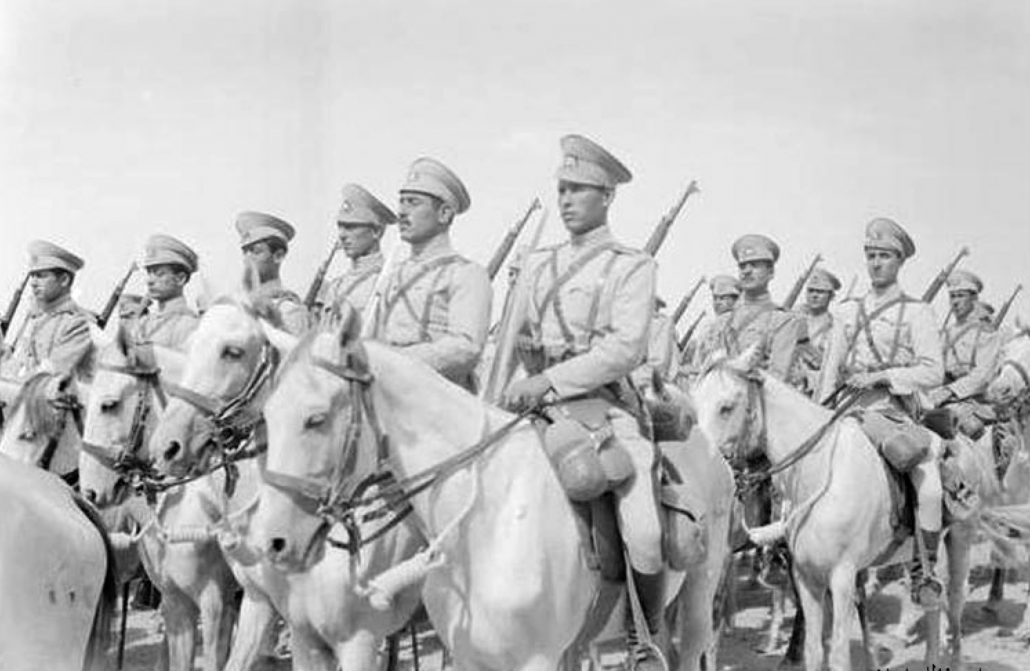 Iranian cavalry in the 1930s (Source: lead-adventure.de). Despite the procurement of armored vehicles and their integration into the Iranian army, cavalry remained Iran’s prime asset for rapid strikes, shock and maneuver on the battlefield (Ward, 2009, p.142). One of the few successes scored by the Iranian army against the Anglo-Soviet invasion of late August 1941, was when an Iranian cavalry patrol forced back an advancing British force near the Paltak pass (in the Kermanshah area, western Iran) on August 27, and took numbers of them prisoner.
Iranian cavalry in the 1930s (Source: lead-adventure.de). Despite the procurement of armored vehicles and their integration into the Iranian army, cavalry remained Iran’s prime asset for rapid strikes, shock and maneuver on the battlefield (Ward, 2009, p.142). One of the few successes scored by the Iranian army against the Anglo-Soviet invasion of late August 1941, was when an Iranian cavalry patrol forced back an advancing British force near the Paltak pass (in the Kermanshah area, western Iran) on August 27, and took numbers of them prisoner.



